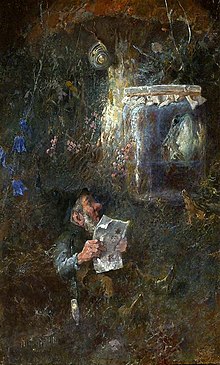The Real Gnome Caught On Camera
A gnome /noʊm/[1] is a mythological creature and diminutive spirit in Renaissance magic and alchemy, first introduced by Paracelsus in the 16th century and later adopted by more recent authors including those of modern fantasy literature. Its characteristics have been reinterpreted to suit the needs of various story tellers, but it is typically said to be a small humanoid that lives underground
Gnom mit Zeitung und Tabakspfeife (English: Gnome with newspaper and tobacco pipe) by Heinrich Schlitt (1923) |
Origins[edit]
The word comes from Renaissance Latin gnomus, which first appears in A Book on Nymphs, Sylphs, Pygmies, and Salamanders, and on the Other Spirits by Paracelsus, published posthumously in Nysa in 1566 (and again in the Johannes Huser edition of 1589–1591 from an autograph by Paracelsus).[3]
The term may be an original invention of Paracelsus, possibly deriving the term from Latin gēnomos (itself representing a Greek γη-νομος, literally "earth-dweller"). In this case, the omission of the ē is, as the Oxford English Dictionary (OED) calls it, a blunder. Paracelsus uses Gnomi as a synonym of Pygmæi and classifies them as earth elementals. He describes them as two spans high, very reluctant to interact with humans, and able to move through solid earth as easily as humans move through air.[4] The chthonic, or earth-dwelling, spirit has precedents in numerous ancient and medieval mythologies, often guarding mines and precious underground treasures, notably in the Germanic dwarfs and the Greek Chalybes, Telchines or Dactyl
In Romanticism and modern fairy tales[edit]
The English word is attested from the early 18th century. Gnomes are used in Alexander Pope's "The Rape of the Lock". The creatures from this mock-epic are small, celestial creatures which were prudish women in their past lives, and now spend all of eternity looking out for prudish women (in parallel to the guardian angels in Catholic belief). Other uses of the term gnome remain obscure until the early 19th century, when it is taken up by authors of Romanticist collections of fairy tales and becomes mostly synonymous with the older word goblin.
Pope's stated source, the French satire (by Nicolas-Pierre-Henri de Montfaucon de Villars, the abbot of Villars) Comte de Gabalis (1670) describes gnomes as such:
Villars used the term gnomide to refer to female gnomes (often "gnomid" in English translations).[6] Modern fiction instead uses the word "gnomess" to refer to female gnomes.[7][8]
In 19th-century fiction, the chthonic gnome became a sort of antithesis to the more airy or luminous fairy. Nathaniel Hawthorne in Twice-Told Tales (1837) contrasts the two in "Small enough to be king of the fairies, and ugly enough to be king of the gnomes" (cited after OED). Similarly, gnomes are contrasted to elves, as in William Cullen Bryant's Little People of the Snow (1877), which has "let us have a tale of elves that ride by night, with jingling reins, or gnomes of the mine" (cited after OED).
One of the first movements in Mussorgsky's 1874 work Pictures at an Exhibition, named "Gnomus" (Latin for "The Gnome"), is written to sound as if a gnome is moving about, his movements constantly changing in speed.
Franz Hartmann in 1895 satirized materialism in an allegorical tale entitled Unter den Gnomen im Untersberg. The English translation appeared in 1896 as Among the Gnomes: An Occult Tale of Adventure in the Untersberg. In this story, the Gnomes are still clearly subterranean creatures, guarding treasures of gold within the Untersberg mountain.
As a figure of 19th-century fairy tales, the term gnome became largely synonymous with other terms for "little people" by the 20th century, such as goblin, brownie, kobold, leprechaun, Heinzelmännchen and other instances of the "domestic spirit" type, losing its strict association with earth or the underground world.




No comments:
Post a Comment
if you have any doubts.please let me know